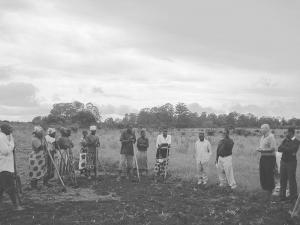2013 - Volume #37, Issue #6, Page #24
[ Sample Stories From This Issue | List of All Stories In This Issue | Print this story
| Read this issue]
Farm Plots Show African Farmers How To Improve Crop Yields
 |
 |
The Companion Village Project (CVP) says results have been impressive since the first Tanzanian plots were planted in 2008 with half an acre each of corn and beans.
“The best yield for corn has been 130 bushels an acre,” says Dr. Roger Blomquist, current director of the Institute of Agriculture at the University of Iringa in Tanzania, which oversees the organization’s activities. “Farmers who use our techniques can increase their production from 3 to 5 times over previous yields. They grow white corn that they harvest, dry and grind into flour for their staple food source. They also raise edible beans. We’re hearing stories of local farmers who now have enough crops to sell to pay for school fees and medical expenses.”
That’s a big improvement from the past, when a farmer couldn’t even grow enough to feed his family.
The farmers use hand tools on their farms of between 2 and 5 acres, and follow the basic practices taught by the retired and active professors, and agri-business leaders who serve as volunteers and pay their own way to travel to Tanzania to teach at the 50 villages where the 1-acre plots have been established. Three Tanzanians with masters’ degrees in agriculture, who studied for 16 months in the U.S., oversee the plots and the program itself.
“It’s been an interesting relationship that we’ve developed. Farmers tell us that when we first came, they didn’t believe our farming practices would work. But after they see the demonstration plots, they understand how well they work,” Blomquist says.
The demonstration plots prove to them that yields improve greatly by planting corn every 8 in. in straight rows 24 in. apart. They see the value of soil testing, using improved seed, adding fertilizers, crop rotation, minimum tillage and managing residue (instead of burning it).
Recently the CVP has developed relationships with Pioneer Seed Company, and Yara Fertilizer Company, in hopes of improving the availability of seed and fertilizer to remote villages.
The plots are organized through the local churches, because the pastors are often the most educated and respected person in the village. Plots are located next to schools or churches in high traffic areas to increase visibility. Field days and demonstrations are open to everyone.
The project has been rewarding, says Blomquist, and there is much more that can be accomplished.
People interested in supporting the CVP can sponsor a demonstration plot, travel to Tanzania to teach, or donate money to pay for expenses that directly relate to the plots.
“We don’t give money to farmers,” he notes. “We give them education, and demonstrate how to use seed and fertilizer.”
In the end, the goal is to yield a better future for farmers and their families.
Contact: FARM SHOW Followup, Companion Village Project, Institute of Agriculture Foundation, University of Iringa, 1900 7th St. N.W., New Brighton, Minn. 55112 (ph 651 636-9559); roger_blomquist@comcast.net; www.tumainiag.org).

Click here to download page story appeared in.

Click here to read entire issue
To read the rest of this story, download this issue below or click here to register with your account number.




